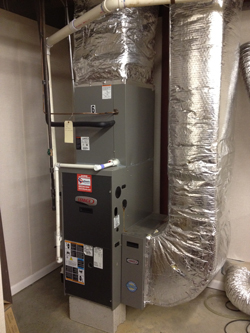In Business Since | License #
In Business Since | License #


This high-efficiency gas furnace includes an air conditioning module, direct venting, and well-insulated ducts to reduce heat and cooling loss.
Furnaces and boilers represent the two largest categories of heating systems used for houses and for buildings in general. The main difference between these two heating appliances is what they heat: Furnaces heat air that is distributed by a ductwork system. Boilers heat water that is used in different "hydronic" heating systems. So-called "combi-boilers" are designed to supply hot water for washing as well as for whole-house heating.
Furnaces and boilers usually burn gas, propane or fuel oil. Less frequently, you'll find units that burn wood, pellet fuel or coal.
If you're in need of furnace or boiler installation or repair, Dr. Energy Saver can ensure high-quality solutions on every job. All of our local dealers are fully trained and certified in home heating systems. Contact us today for efficient, effective furnaces and boilers!
Heating with a furnace provides you with a ductwork system that can also distribute cool air from a central air conditioning system during hot summer months. With boiler-based heating, you don't get any ductwork unless your hot water supplies a "hydro-air" forced-air heating system.
Fortunately, it's easy to compare furnaces and boilers in terms of size, efficiency and combustion. These designations are all the same, as described below.
A furnace or boiler more than 10 years old is probably operating in the range of 75%-80% AFUE. Today the best "high-efficiency" furnaces and boilers can operate at 96% AFUE. Many homeowners choose to upgrade to a high-efficiency furnace or boiler even though an older model is still working well. As energy prices continue to rise, an appliance that's more than 20% more efficient really starts to pay for itself.
To make the most of these energy savings, work with a Dr. Energy Saver dealer. Our certified contractors know proper installation and maintenance techniques to give your home the best comfort and energy savings possible. Schedule a home energy audit with your local dealer today!
Looking for a price? Get a no cost, no obligation free estimate.